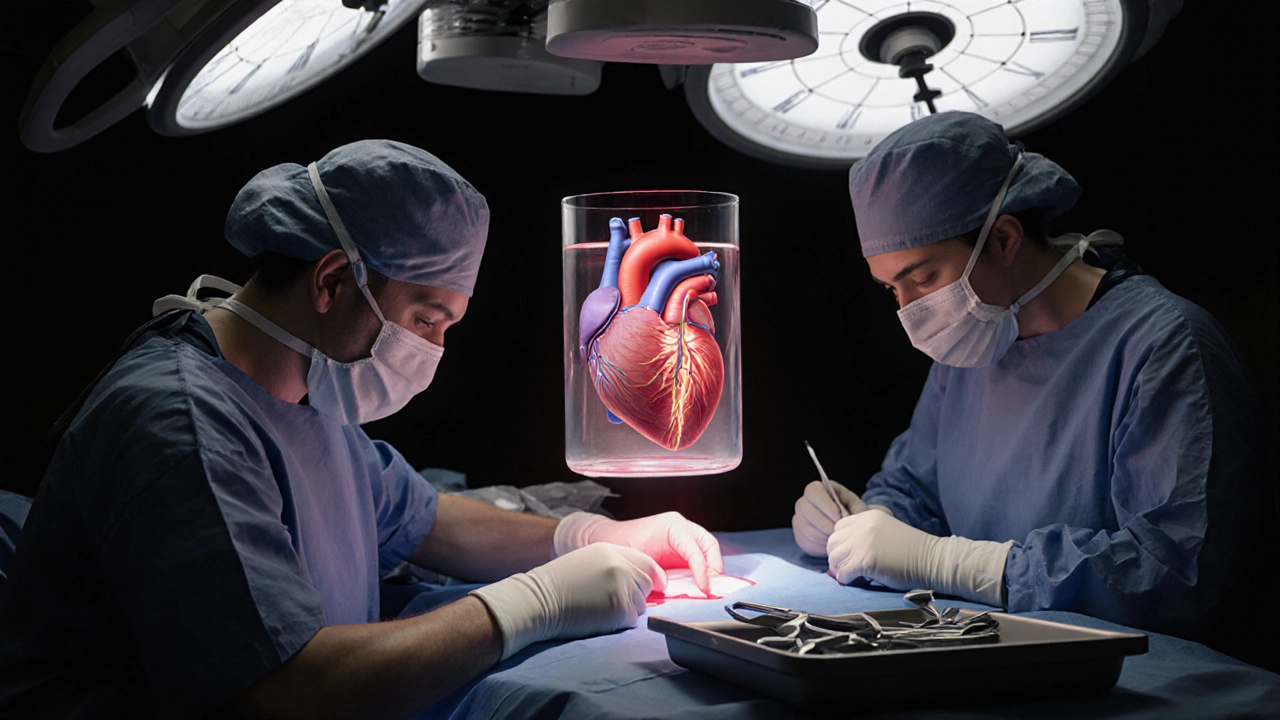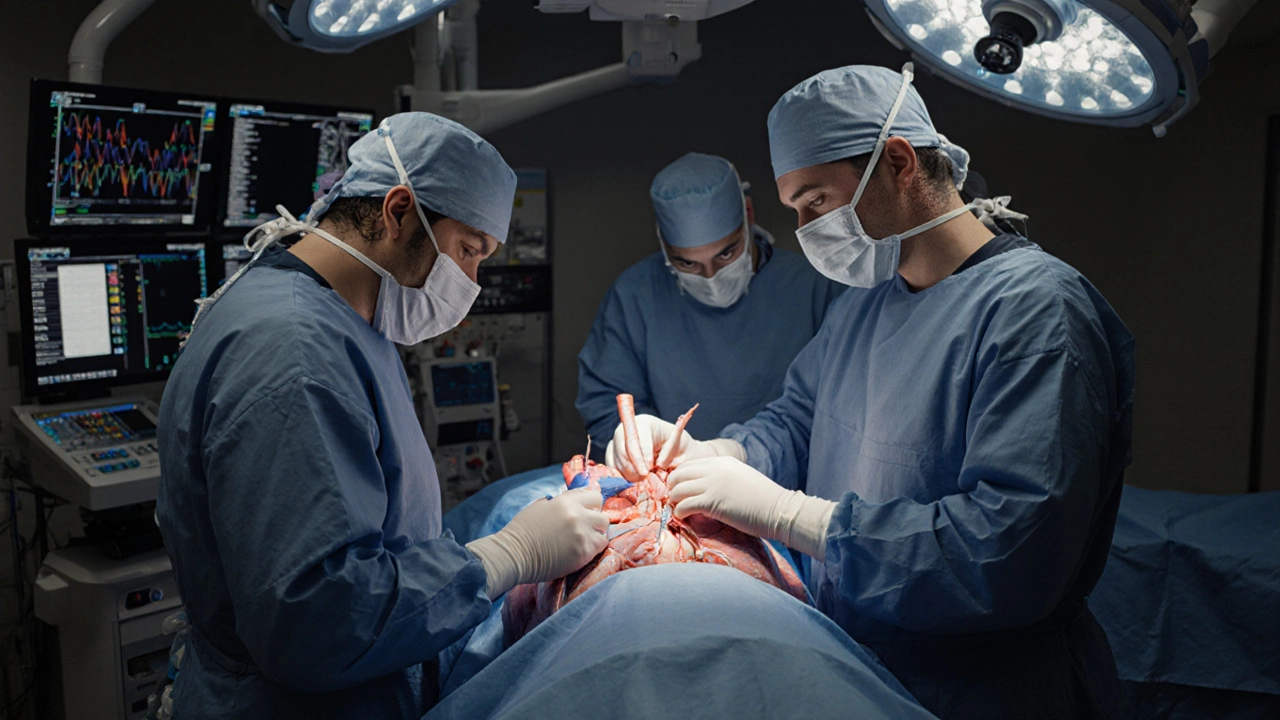Heart Surgery Duration Calculator
Estimated Procedure Time
Based on article data: Times vary significantly based on surgical complexity and patient-specific factors.
When someone you love needs heart surgery, the biggest question isn’t always about the risks or the doctor-it’s often, how long will this take? You’re sitting in a hospital waiting room, scrolling through your phone, trying not to think about what’s happening inside. The clock ticks. Every minute feels longer. And no one gives you a straight answer.
There’s no single answer. Heart surgery isn’t one thing. It’s a whole family of procedures, each with its own clock. A simple repair might take two hours. A complex multi-vessel bypass could stretch past six. It depends on the problem, the patient’s health, and even the surgeon’s technique.
What kind of heart surgery are we talking about?
Not all heart surgeries are the same. The time changes based on what’s being fixed.
Coronary artery bypass grafting (CABG) is the most common. This is when blocked arteries are bypassed using veins or arteries from elsewhere in the body. For a single vessel, it can take 3 to 4 hours. For three or more vessels-common in patients with advanced heart disease-it often runs 4 to 6 hours. If the patient has diabetes, kidney issues, or has had prior surgeries, the time can creep up to 7 hours. Surgeons have to be extra careful with scar tissue from old operations, which slows everything down.
Valve replacement or repair is another big one. Replacing a leaky or narrowed aortic valve with a mechanical or biological valve usually takes 3 to 5 hours. Mitral valve repair, which is often preferred over replacement because it preserves more of the natural heart, can take longer-sometimes 5 to 6 hours. Why? Because it’s more delicate. You’re not just swapping parts; you’re reshaping tissue, sewing in annuloplasty rings, and making sure the valve opens and closes perfectly. One wrong stitch, and the patient could need another surgery later.
Heart transplant is the longest and most complex. The surgery itself takes 4 to 8 hours. But that’s just the start. Finding a matching donor heart, getting it to the hospital in time, and preparing the recipient’s body for the new organ adds hours before the knife even touches skin. The team must work like a relay race-each second counts. If the donor heart is warm too long, it won’t survive. If the recipient’s body rejects it, everything fails.
Minimally invasive procedures like transcatheter aortic valve replacement (TAVR) are faster. These don’t require opening the chest. Instead, a catheter is threaded through the groin or chest to replace the valve. These usually take 1 to 3 hours. Recovery is quicker, too. But they’re not for everyone. Patients with severe calcification, complex anatomy, or other heart conditions may still need open surgery.
What makes a heart surgery take longer?
It’s not just the type of surgery. The patient’s body tells its own story.
Age matters. Older patients often have stiffer arteries, weaker hearts, and more scar tissue. A 78-year-old with a history of smoking and high blood pressure will take longer than a 55-year-old with no other health issues-even if they both need the same bypass.
Previous surgeries are a big factor. If someone had open-heart surgery five years ago, the surgeon has to cut through layers of scar tissue. That’s like peeling off dried glue. It slows things down and increases bleeding risk. Surgeons have to work slower, more carefully. That adds time.
Unexpected complications can stretch the clock. A vessel tears. The heart rhythm goes haywire. The patient’s blood pressure drops. These aren’t rare. In fact, about 1 in 10 open-heart surgeries encounter some kind of intraoperative hiccup. Each one adds 15 to 45 minutes. The team has to stabilize the patient, adjust the plan, and keep going.
Even the hospital matters. In high-volume centers-like those doing over 500 heart surgeries a year-the teams are sharper. Nurses, anesthesiologists, perfusionists-they’ve done this hundreds of times. They move in sync. The transition from cutting to bypass to closing happens smoothly. In smaller hospitals, the same surgery might take 30 to 60 minutes longer just because coordination isn’t as tight.

What happens during the surgery?
People think the surgeon is the only one working. But heart surgery is a team sport.
Before the first cut, the patient is put under deep anesthesia. The anesthesiologist monitors breathing, blood pressure, and heart rhythm constantly. A perfusionist runs the heart-lung machine, which takes over the heart and lungs so the surgeon can operate on a still heart. This machine keeps blood flowing and oxygenated while the heart is stopped.
The surgeon makes the incision-usually down the middle of the chest. The ribs are spread open. The heart is exposed. If it’s a bypass, veins are taken from the leg or artery from the chest. Each graft is carefully stitched to the blocked artery. One graft takes 10 to 20 minutes. Three grafts? That’s 30 to 60 minutes right there.
Valve surgery is even more precise. The old valve is removed. The new one is measured, tested, and sewn in. Every suture must be perfect. Too loose? The valve leaks. Too tight? It won’t open. Surgeons use tiny instruments, sometimes under a microscope. One mistake, and the patient could need another surgery in months.
When it’s done, the heart is restarted. Sometimes it starts on its own. Sometimes it needs a small electric shock. The patient is slowly weaned off the heart-lung machine. Blood pressure is stabilized. The chest is closed with wires. The skin is stitched. The whole process-from first cut to last stitch-is a marathon of precision.
How long is recovery after surgery?
Time in the operating room doesn’t tell the whole story.
After surgery, patients spend 1 to 3 days in the ICU. They’re on a ventilator at first, then slowly breathe on their own. Pain is managed. Fluids are monitored. Heart rhythms are watched like hawks.
Most patients stay in the hospital for 5 to 7 days total. Then comes rehab. Walking a few steps on day 3. Sitting up in a chair. Climbing stairs by day 7. Full recovery takes 6 to 12 weeks. Some take longer. Older patients, or those with diabetes or lung disease, might need 3 to 6 months to feel like themselves again.
Physical therapy is part of the process. Cardiac rehab programs help patients rebuild strength safely. These programs aren’t optional-they’re life-saving. Studies show patients who complete rehab have a 25% lower chance of being readmitted to the hospital.

Can heart surgery be done faster?
Yes-and no.
Technology has cut time in some cases. Robotic-assisted surgery allows smaller incisions and less trauma. But it doesn’t always speed things up. Setting up the robot, calibrating it, training the team-it adds prep time. The actual repair might be faster, but the total time in the OR doesn’t always drop.
Minimally invasive techniques like TAVR or keyhole mitral repair are faster. But they’re not for every patient. Only about 30% of valve patients qualify. The rest still need open surgery.
There’s no magic shortcut. The heart is too delicate. Too many things can go wrong. Surgeons won’t rush. They can’t. Speed might save minutes in the OR, but it could cost years of life later.
What should families expect?
Don’t rely on a single number. Ask the surgical team for a range.
“We expect this to take 4 to 6 hours,” is a realistic answer. “It could be longer if we find something unexpected.” That’s the truth.
Plan for a full day. Even if the surgery ends at 2 p.m., the patient won’t be out of recovery until 5 or 6 p.m. The family will be told when the surgery starts, but not when it ends. That’s normal. Surgeons don’t know the exact end time until they’re done.
Bring a book. A charger. A blanket. And patience. This isn’t a quick fix. It’s a journey.
Heart surgery isn’t just about cutting and sewing. It’s about timing, teamwork, and trust. Every minute counts-not because it’s long, but because every second is spent keeping someone alive.
